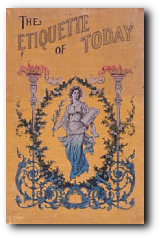


“Hospitality is a great pleasure to people of a sociable nature, and its obligations have a most refining influence. The generous consideration of others reaches its acme when one is constantly entertaining little circles of friends, with no thought but to give happiness.”
Edith. B. Orday

Etiquette of Today
Author: Edith B. Orday Published: 1918
Personality
Family Etiquette
Conversation and Correspondence
Casual Meetings and Calls
The Personal Card and the Engraved Invitation
Behavior in Public
The Art of Being a Guest
Duties of Host and Hostess
Duties of the Chaperon
Etiquette of the Marriage Engagement
The Conduct of a Wedding
Etiquette for Children
Etiquette of Mourning
Military, Naval, and Flag Etiquette

CHAPTER XIV
ETIQUETTE OF MOURNING
UPON the occasion of a death in the family a reliable undertaker is at once notified and his suggestions followed as to the necessary preparations to be made for the funeral.
The shades are drawn throughout the front of the house, as a sign that the family is in retirement. The women of the family are not seen upon the street unless necessary, the men taking full charge of all business matters. The directions which the undertaker desires should be decided upon by the family, or nearest relative of the deceased, and then some one member of the family should be delegated to see that they are carried out. Palm leaves tied with ribbon or chiffon, spray bouquets of white flowers tied with ribbon, an ivy wreath broken with a bunch of purple everlasting, are much preferred to crape upon the door.
Press notices of the funeral and death should be sent to the newspapers. The conduct of the funeral should be arranged with the clergyman chosen to officiate, the superintendent of the cemetery consulted (usually through the undertaker), and the notes of request sent to those chosen to act as pallbearers. Sometimes the latter are purely honorary, the undertaker furnishing the bearers. The honor is usually given to intimate family friends, or close business associates in case of a business man.
A carriage is always provided for the clergyman, and he is entitled to a fee, although clergymen do not charge it, either at a home or church funeral. If the service is held at a church, the sexton, organist and singers,--and the singers at a home funeral as well,--are entitled to recompense for their services.
Carriages are sent for the pallbearers, and are also provided to convey the family, and as many of the friends as may be invited to go, to the cemetery.
One may announce in the newspaper "Burial private," in which case it is understood that only the family attend at the grave; or "No flowers" if the family wish the usual sending of flowers dispensed with.
The clergyman usually consults the wishes of the family as to the form of service, the hymns or music, and remarks. The funeral service should be brief, and preferably a ritual service with no sermon or eulogy. The last are usually harrowing to the feelings of the mourners, and there should be every reasonable effort made to relieve the tension of the occasion, for the sake of the living.
At a church funeral the pallbearers sit in the first pews at the left of the center aisle; the family in those to the right. At a home funeral it is customary to have the family in some secluded room near the one where the coffin is placed and to have the clergyman stand in the hall between, or at the entrance of the drawing-room, where he may be readily heard by all.
If the service at the grave immediately follows the funeral the house should meanwhile be aired, the shades lifted, the flowers all sent away to some hospital, and the rooms arranged in the usual way.
Before a funeral at the home, it is necessary for some member of the family to receive the relatives from the distance, and the very intimate friends, and see that they are given necessary refreshment, and their return to trains, if they must leave immediately after the funeral, thoroughly understood by the hackmen.
At a home funeral the singers should be somewhat distant from the family, so that the music is not loud.
The members of the family are dressed in hats and veils ready to enter the carriages, before the service. They pass to view the body,--if, according to a former custom, the casket is left open,--last of all, and enter the last carriage before that of the pallbearers, which immediately precedes the hearse.
In sending flowers to a funeral, one's card is enclosed. There should be no slightest sense of obligation in the sending of flowers, and each piece should represent only real sympathy or respect.
The putting on of black garments as a sign that one has lost a near relative has been much modified by the good sense of the people, and the period of mourning shortened, especially in England. In stating the accepted mourning custom, the moderate observance of it has been given, both extremes being ignored.
Crape is the quality of goods most closely allied with mourning. Black dresses trimmed with black crape are usually worn for the first few months by women who have lost a near relative. The black veil worn by widows is now of moderate length, and usually not of the very thick material which was once in vogue. A ruche of white is now placed just inside the bonnet, which relieves the black effect somewhat. Black furs and sealskins are worn with mourning.
The English fashion of six months of the deepest mourning and six months of secondary is meeting with more and more approval in this country, although for a close relative a year is the first period and six months the second.
One who is in mourning does not appear in society for the first six months; after that it is permissible to attend a concert or musical, but not the theater or a reception while severe mourning is worn.
During the mourning period, black-bordered stationery is used. The border on paper and envelopes is usually three-eighths of an inch for a close relative and half that for a more distant one, or during the secondary period of mourning, if one cares to make the change. The personal visiting card has a black border during this time.
The handkerchief is bordered with narrow black, or is of narrow-bordered, plain, sheer linen.
For relatives-in-law it is not customary to put on black, although for a father- or mother-in-law it is customary, in the best society, to dress nearly as for an own father or mother.
A widower wears a complete suit of black, white linen, dull-black silk neckties, dull-black leather shoes, black gloves, and a black ribbon of broader width upon his hat.
The mourning band sewed upon the coat sleeve is a discredited form of mourning. It does not denote the nearness of the loss, and has only the virtue of cheapness for those who cannot afford to show marked respect to the dead.
Men do not observe the custom of withdrawing from society for as long a time as do the women, but usually reappear at the homes of intimate friends, at public places of entertainment, and at the club after two or three months. As long as the mourning band is worn upon the hat, however, no man should attend large and fashionable functions, as dinner or dancing parties, or the theater.
After six months a woman may resume calling, returning the calls of those who called upon her in the early weeks of her bereavement.
Children of fifteen years of age and under should not wear mourning.
The viewing of the body of the deceased as it lies in the casket is the privilege of only the family and the immediate friends, and should not be requested by others. Therefore, the casket is now usually closed before the funeral service, especially if that be at a church. In case of a man in public office, it is sometimes necessary that the body should lie in state for certain hours, when the public may pay their respects.
Punctuality is very necessary in regard to everything connected with a funeral service, as the overwrought nerves of those who are sorrowing should not be taxed to bear any extra tension.
Within ten days after the funeral, a card of thanks for sympathy should be sent to all who have called upon the family or sent flowers or offered their services in any way.
When one is in mourning, one does not attend a wedding reception, though one may be present at the ceremony. Black should not be worn.
Mourners announce their return to society by sending out their cards to friends and acquaintances.
2011 © Church Growth Associates, Inc.